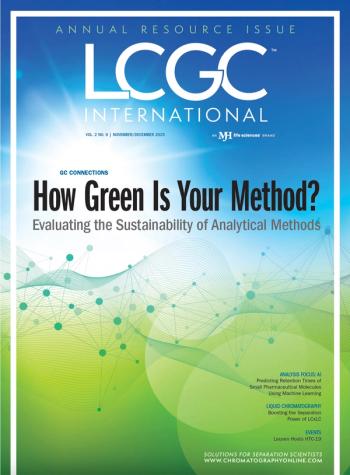
Distinguishing Alcohol- from Non-Alcohol-Associated Liver Cirrhosis with LC-MS
A pilot study investigating whether nicotinamide adenine dinucleotide kinase (NADK) expression is selectively diminished in alcohol-associated liver cirrhosis (AC), as well as evaluating its potential as a biomarker for this condition, measured AC and non-AC (NAC). Nicotinamide adenine dinucleotide (NAD+) and nicotinamide adenine dinucleotide phosphate (NADP+) levels in human liver samples were measured using liquid chromatography-mass spectrometry (LC-MS).
A pilot study conducted by researchers from South Korean colleges and universities set out to investigate the effect of alcohol consumption on nicotinamide adenine dinucleotide kinase (NADK) levels in the liver, inspired by a hypothesis that NADK is specifically decreased in alcohol-associated liver cirrhosis (AC). By revealing this relationship, the team hoped to uncover novel therapeutic targets and contribute to the development of treatments for metabolic distributions in alcohol-associated liver disease (ALD), ultimately improving clinical outcomes for patients with chronic liver disease. Liquid chromatography-mass spectrometry (LC-MS) was used to measure AC and non-AC (NAC), nicotinamide adenine dinucleotide (NAD+) and nicotinamide adenine dinucleotide phosphate (NADP+) levels in human liver samples. A paper based on this research was published in Clinical and Experimental Hepatology (1).
The leading causes of chronic liver disease globally, ALD and non-alcoholic fatty liver disease (NAFLD), while sharing similar histological features such as steatosis and inflammation, differ in etiology. ALD results from excessive alcohol consumption, whereas NAFLD is associated with metabolic factors such as obesity and insulin resistance (2,3).
Chronic intake of alcohol is not only the cause of direct hepatic injury, but also leads to histological changes, such as hepatocyte ballooning and fibrosis (4,5). The pathogenesis of AC involves oxidative stress (which is induced by alcohol metabolism), as well as the toxic effects of acetaldehyde, the primary metabolic byproduct of alcohol (6,7).
Essential for converting NAD+ into NADP+, NADK plays a pivotal role in cellular metabolism and antioxidant defense mechanisms (8,9). Previous research indicated that a deficiency of mitochondrial NADK in mouse models leads to hepatic injury, which highlights its significant role in liver metabolism (10). In ALD, a marked reduction in the NAD+ metabolome indicates the vital role of NADK in the management of metabolic stress in liver tissues (11,12). Alterations in NAD kinase 2 (NADK2) affecting the mitochondrial nicotinamide adenine dinucleotide phosphate (NADP[H]) levels resulted in profound metabolic disturbances, which emphasizes the crucial role of this enzyme in the maintenance of mitochondrial function and overall metabolic health (13).
The researcher’s LC-MS analysis showed significant reduction in NAD+ and NADP+ levels in AC patients compared to both normal and NAC groups, with a corresponding increase in the NAD+/NADP+ ratio (AC = 3.93, NAC = 2.75, normal = 2.64). In addition, 881 AC-specific DEGs, including 27 kinase-encoding genes, were identified. Multi-level expression analyses confirmed a significant decrease in NADK gene expression in AC patients. Immunohistochemistry showed a marked reduction in NADK protein expression in AC patients, underscoring its involvement in altered metabolic processes (1).
The researchers state that their study reveals a distinct decrease in NADK expression in AC, which suggests its utility as a molecular marker for diagnosing and understanding metabolic dysregulation in these patients. These findings, they conclude, provide a foundation for developing targeted therapeutic strategies for alcohol-associated liver cirrhosis (1).
References
1. Park, K. H.; Kim, S. H.; Kim, S.W. et al. NADK as a Molecular Marker to Distinguish Between Alcohol- and Non-Alcohol-Associated Liver Cirrhosis: A Pilot Study. Clin. Exp. Hepatol. 2025, 11 (1), 71-80. DOI:
2. Toshikuni, N.; Tsutsumi, M.; Arisawa, T. Clinical Differences Between Alcoholic Liver Disease and Nonalcoholic Fatty Liver Disease. World J. Gastroenterol. 2014, 20 (26), 8393-8406. DOI:
3. Díaz, L. A.; Arab, J. P.; Louvet, A. et al. The Intersection Between Alcohol-Related Liver Disease and Nonalcoholic Fatty Liver Disease. Nat. Rev. Gastroenterol. Hepatol. 2023, 20 (12), 764-783. DOI:
4. Stickel, F.; Datz, C.; Hampe, J. et al. Pathophysiology and Management of Alcoholic Liver Disease: Update 2016. Gut Liver. 2017, 11 (2), 173-188. DOI:
5. Lackner, C.; Tiniakos, D. Fibrosis and Alcohol-Related Liver Disease. J. Hepatol. 2019, 70 (2), 294-304. DOI:
6. Osna, N. A.; Donohue, T. M. Jr.; Kharbanda, K. K. Alcoholic Liver Disease: Pathogenesis and Current Management. Alcohol Res. 2017, 38 (2), 147-161.
7. Hyun, J.; Han, J.; Lee, C. et al. Pathophysiological Aspects of Alcohol Metabolism in the Liver. Int. J. Mol. Sci. 2021, 22 (11), 5717. DOI:
8. Oka, S. I.; Titus, A. S.; Zablocki, D. et al. Molecular Properties and Regulation of NAD+ Kinase (NADK). Redox Biol. 2023, 59, 102561. DOI:
9. Pollak, N.; Niere, M.; Ziegler, M. NAD Kinase Levels Control the NADPH Concentration in Human Cells. J. Biol. Chem. 2007, 282 (46), 33562-33571. DOI:
10. Zhang, K.; Kim, H.; Fu, Z. et al. Deficiency of the Mitochondrial NAD Kinase Causes Stress-Induced Hepatic Steatosis in Mice. Gastroenterology 2018, 154 (1), 224-237. DOI:
11. Parker, R.; Schmidt, M. S.; Cain, O,. et al. Nicotinamide Adenine Dinucleotide Metabolome Is Functionally Depressed in Patients Undergoing Liver Transplantation for Alcohol-Related Liver Disease. Hepatol. Commun. 2020, 4 (8), 1183-1192. DOI:
12. Yue, R.; Chen, G. Y.; Xie, G. et al. Activation of PPARα-Catalase Pathway Reverses Alcoholic Liver Injury via Upregulating NAD Synthesis and Accelerating Alcohol Clearance. Free Radic. Biol. Med. 2021, 174, 249-263. DOI:
13. Houten, S. M.; Denis, S.; Te Brinke, H. et al. Mitochondrial NADP(H) Deficiency Due to a Mutation in NADK2 Causes Dienoyl-CoA Reductase Deficiency with Hyperlysinemia. Hum. Mol. Genet. 2014, 23 (18), 5009-5016. DOI:
Newsletter
Join the global community of analytical scientists who trust LCGC for insights on the latest techniques, trends, and expert solutions in chromatography.



